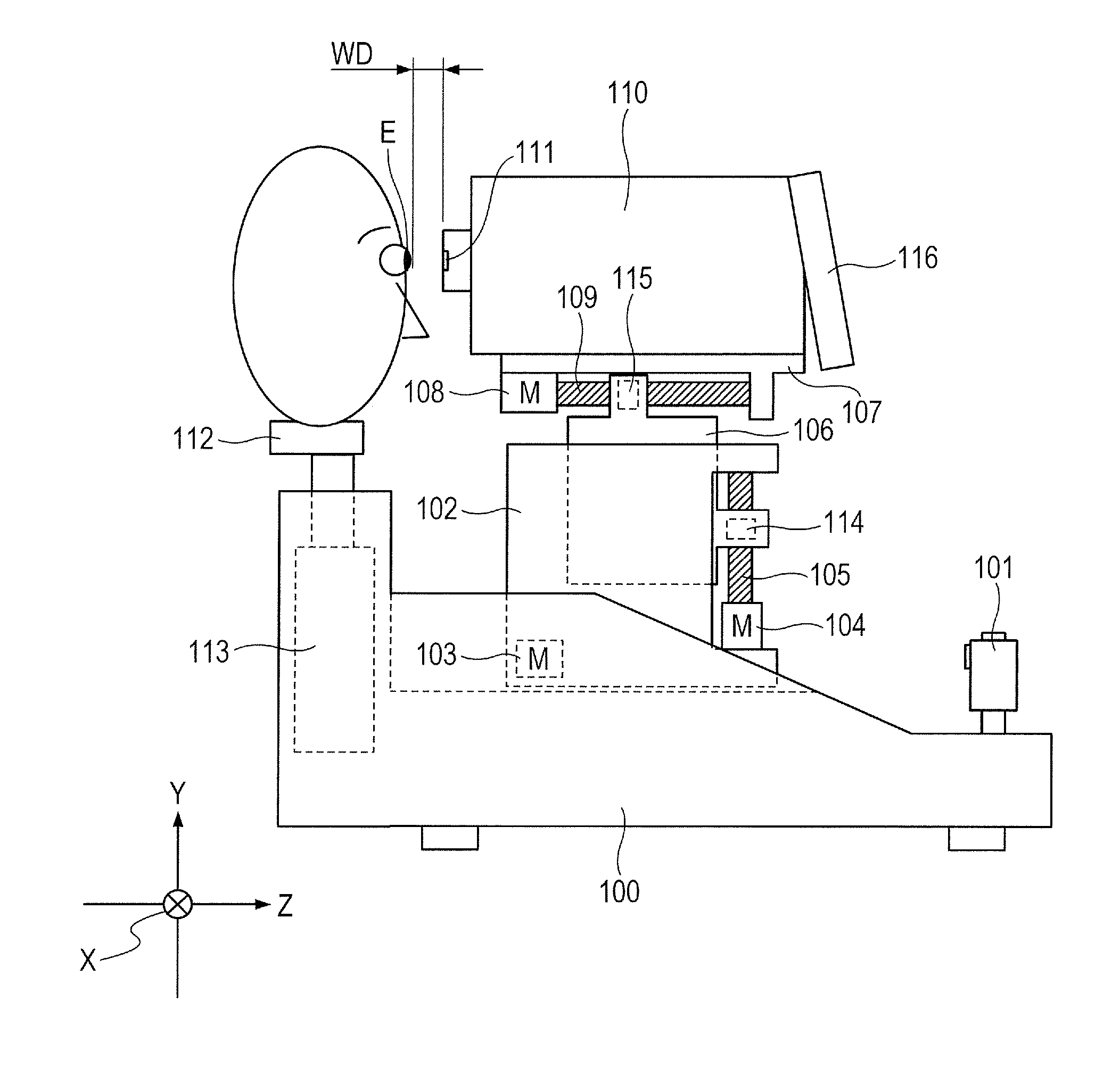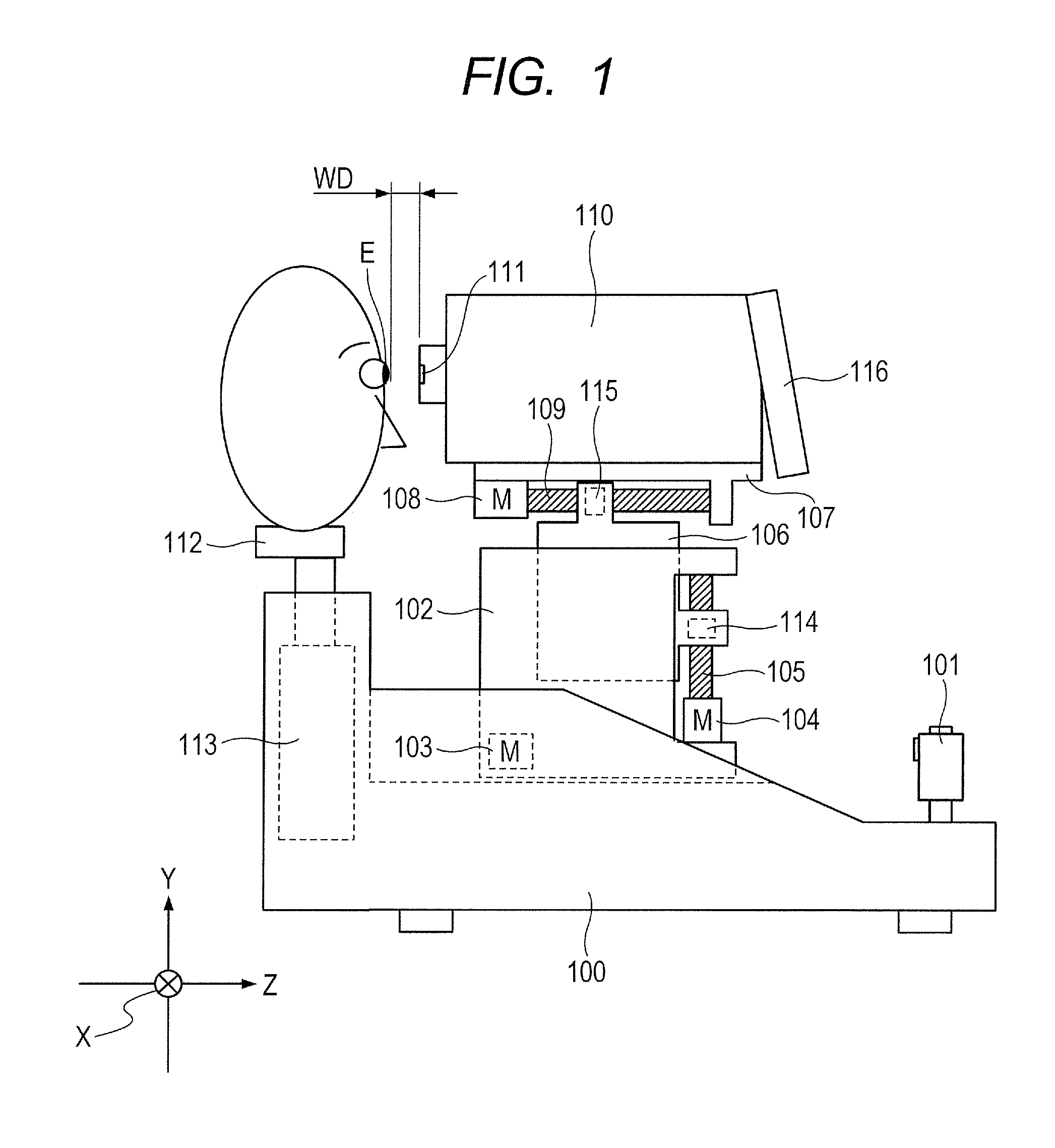Non-contact tonometer
a tonometer and non-contact technology, applied in the field of tonometers, can solve the problems of complicated control circuits, difficult to stop the piston at a target position, annoying objects, etc., and achieve the effect of suppressing unnecessary puffing and simple arrangemen
- Summary
- Abstract
- Description
- Claims
- Application Information
AI Technical Summary
Benefits of technology
Problems solved by technology
Method used
Image
Examples
first embodiment
[0035]FIG. 1 is a view showing the schematic arrangement of a non-contact tonometer according to the present invention.
[0036]A frame 102 is movable in the left-and-right direction (to be referred to as an X axis direction hereinafter) with respect to a base 100. A drive system in the X axis direction is constituted by an X axis drive motor 103 fixed on the base 100, a feed screw (not shown) coupled to a motor output axis, and a nut (not shown) fixed to the frame 102 so as to be movable on the feed screw in the X axis direction. The motor 103 rotates to move the frame 102 in the X axis direction via the feed screw and nut.
[0037]A frame 106 is movable in the up-and-down direction (to be referred to as a Y axis direction hereinafter) with respect to the frame 102. A drive system in the Y axis direction is constituted by a Y axis drive motor 104 fixed on the frame 102, a feed screw 105 coupled to a motor output axis, and a nut 114 fixed to the frame 106 so as to be movable on the feed s...
second embodiment
[0091]FIG. 11 is a view showing the outer appearance of a cylinder portion according to the second embodiment of the present invention. As in the first embodiment, a plurality of air vent holes Ap1 to Ap4 are formed in the outer wall of a cylinder 43. Electromagnetic valves 50 to 53, and stoppers 54 to 57 are arranged outside the cylinder 43 in correspondence with the respective air vent holes Ap1 to Ap4. The electromagnetic valves 50 to 53 can be independently driven. By driving the electromagnetic valves 50 to 53, the stoppers 54 to 57 can close the air vent holes Ap1 to Ap4. FIGS. 12A to 12D are views for explaining the operation of the cylinder portion in the embodiment. The air vent hole Ap4 is selected in FIG. 12A, the air vent hole Ap3 is selected in FIG. 12B, the air vent hole Ap2 is selected in FIG. 12C, and the air vent hole Ap1 is selected in FIG. 12D. When each air vent hole is selected, it is controlled to close an air vent hole arranged on the side of an eye to be insp...
third embodiment
[0094]FIG. 13 is a view showing the outer appearance of a cylinder portion according to the third embodiment of the present invention. FIGS. 14A to 14D are views for explaining the operation of a cylinder portion in the third embodiment. As shown in FIG. 14A, an elongated air vent hole Ap1 is formed in the outer wall of a cylinder 58. A rotation member 59 for changing the air vent hole position is arranged outside the cylinder 58. An elongated hole is formed at an angle in the outer wall of the rotation member 59 so that it crosses the elongated hole of the cylinder 58. A leakage preventing member 60 is arranged at the intersection between the elongated air vent hole Ap1 of the cylinder 58 and the elongated hole of the rotation member 59 to prevent leakage of air from the groove of the elongated hole of the cylinder 58. Further, a drive gear 47 fitted on the output shaft of a drive motor 48 is arranged to mesh with the gear shape of the flange portion of the rotation member 59. The ...
PUM
 Login to View More
Login to View More Abstract
Description
Claims
Application Information
 Login to View More
Login to View More - R&D
- Intellectual Property
- Life Sciences
- Materials
- Tech Scout
- Unparalleled Data Quality
- Higher Quality Content
- 60% Fewer Hallucinations
Browse by: Latest US Patents, China's latest patents, Technical Efficacy Thesaurus, Application Domain, Technology Topic, Popular Technical Reports.
© 2025 PatSnap. All rights reserved.Legal|Privacy policy|Modern Slavery Act Transparency Statement|Sitemap|About US| Contact US: help@patsnap.com



